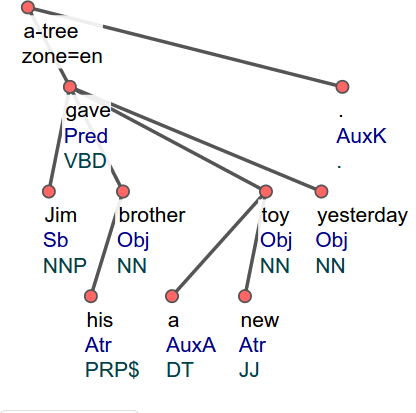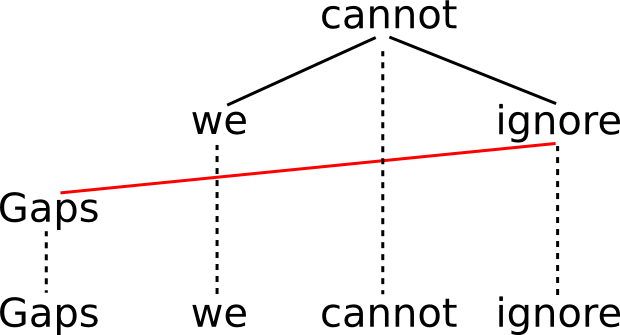Dependency Trees: Difference between revisions
No edit summary |
No edit summary |
||
| (6 intermediate revisions by the same user not shown) | |||
| Line 12: | Line 12: | ||
In most linguistic theories, verbs control their arguments. Therefore, e.g. the subject of a sentence will typically depend on the predicate. Modifiers of the subject (such as adjectives) will depend on the subject node and so on. | In most linguistic theories, verbs control their arguments. Therefore, e.g. the subject of a sentence will typically depend on the predicate. Modifiers of the subject (such as adjectives) will depend on the subject node and so on. | ||
The following is a (Prague-style) dependency parse of the sentence ''Jim gave his brother a new toy yesterday.'' | |||
[[File:deptree.png|250px]] | |||
== Non-Projectivity == | == Non-Projectivity == | ||
In some cases, dependency trees can be non-projective. Intuitively, we can recognize a non-projective tree by drawing downward lines from the nodes ("projecting" them). If any line crosses a dependency edge, the tree is non-projective, such as the following (the non-projective edge is drawn in red): | |||
[[File:nonprojective.png|250px]] | |||
A more formal definition involves the notions of linear and dependency ordering and can be found e.g. [http://ufal.mff.cuni.cz/~lopatkova/2015/docs/1-intro-trees.pdf here]. Note that alternative definitions are sometimes used which may and may not be always equivalent. | |||
In the data, roughly one quarter of Czech sentences contain a non-projective edge, while only about 8 percent of English sentences do. | |||
Fortunately, even for Czech, most non-projective sentences contain at most one "gap". Mildly context-sensitive grammars, such as the tree-adjoining grammar (TAG), can be used to analyze such sentences. | |||
== See Also == | == See Also == | ||
[http://ufal.mff.cuni.cz/~lopatkova/2015/docs/1-intro-trees.pdf Introduction to constituency and dependency trees] | * [http://ufal.mff.cuni.cz/~lopatkova/2015/docs/1-intro-trees.pdf Introduction to constituency and dependency trees] | ||
[https://lindat.mff.cuni.cz/services/treex-web Online demo of Treex which includes dependency parsing for English and Czech] | * [https://lindat.mff.cuni.cz/services/treex-web Online demo of Treex which includes dependency parsing for English and Czech] | ||
Latest revision as of 15:12, 7 August 2015
 | |
| Lecture video: |
web TODO Youtube |
|---|---|
Dependency Tree
A dependency tree is a rooted directed tree with a defined linear ordering of its nodes. The nodes correspond to words in a sentence (in a constituency tree, they could be either nonterminals or words) and the directed edges mark dependency relations between nodes.
In most linguistic theories, verbs control their arguments. Therefore, e.g. the subject of a sentence will typically depend on the predicate. Modifiers of the subject (such as adjectives) will depend on the subject node and so on.
The following is a (Prague-style) dependency parse of the sentence Jim gave his brother a new toy yesterday.
Non-Projectivity
In some cases, dependency trees can be non-projective. Intuitively, we can recognize a non-projective tree by drawing downward lines from the nodes ("projecting" them). If any line crosses a dependency edge, the tree is non-projective, such as the following (the non-projective edge is drawn in red):
A more formal definition involves the notions of linear and dependency ordering and can be found e.g. here. Note that alternative definitions are sometimes used which may and may not be always equivalent.
In the data, roughly one quarter of Czech sentences contain a non-projective edge, while only about 8 percent of English sentences do.
Fortunately, even for Czech, most non-projective sentences contain at most one "gap". Mildly context-sensitive grammars, such as the tree-adjoining grammar (TAG), can be used to analyze such sentences.

